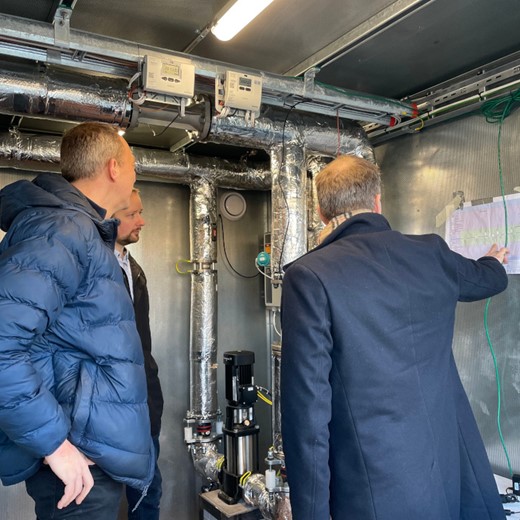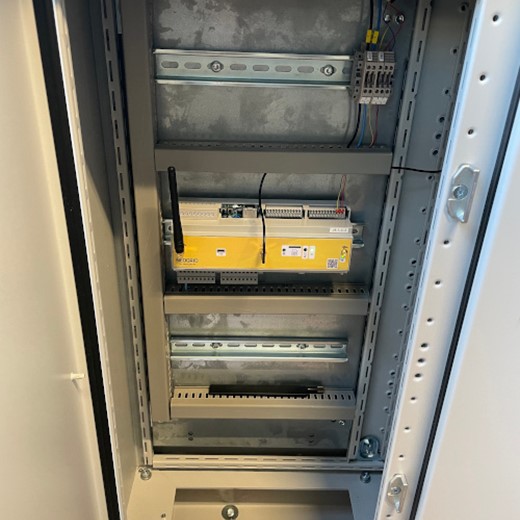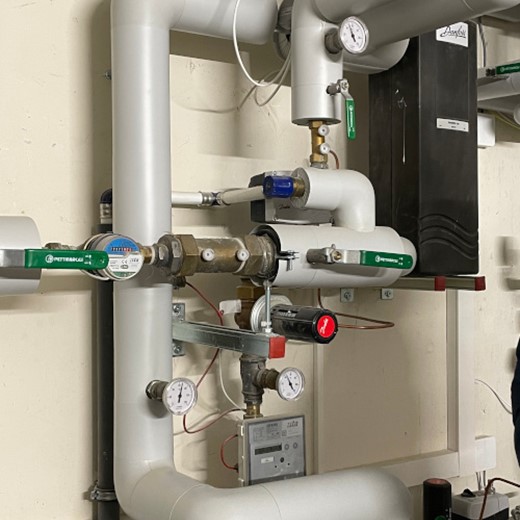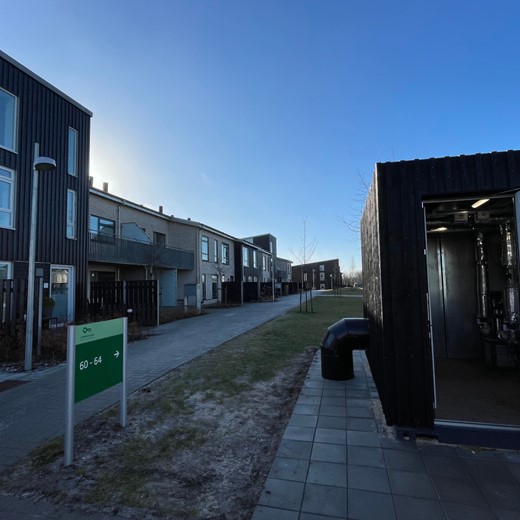Published 04. Jul. 2022
FED living lab tests the district heating system of the future
In a black container at Fyrkildevej in Aalborg, North Denmark, you can find what might become the core of the district heating system of the future: An intelligent mixing loop capable of controlling the district heating system on the basis of, among other things, consumption data and building models of the surrounding residential areas. The aim is to be able to distribute the consumption in the area, enabling a lowering of the outflow temperature. This may lead to marked energy savings, and at the same time it will enable the inclusion of more types of sustainable energy in the district heating system.

One of the main challenges of the current district heating system are the traditional high outflow temperatures and the subsequent significant heat loss in the pipe systems. Often, outflow temperatures are at around 80 degrees Celsius, which also makes including different types of waste heat or other forms of sustainable energy into the system difficult, as these often offer a lower temperature.
Through the new intelligent mixing loop, the temperature from the district heating grid to the buildings is lowered on the basis of the required amounts of heat and hot water that the buildings indicate at any given time. Christian Byrjalsen from utility company Aalborg Forsyning explains:
”In practice, we use the pumps, mixing loop and other equipment in this container for lowering the temperature from the district heating grid. As such, we only send the temperature into the building that is needed. This allows us to lower the heat loss in the pipes, for instance in basement wells, corridors, etc., where the pipes go into each apartment. We actually do not know at this point exactly how much we can lower the temperature - that is part of what we are to test in this living lab. We currently have an energy loss of 17 percent in our grid - and if we can lower that, we can achieve quite significant savings.”

CONTROL BUILDS ON CONSUMPTION DATA
Traditionally, the district heating system is dimensioned to handle peak loads, that is, situations in which consumption in the building is at maximum level. Through collection of data from the buildings, the new mixing loop gets exact information on the actual consumption - not just in the current time slot but also in the coming hours. As such, sensors have been installed in selected apartments in the complexes at Fyrkildevej, including apartments that are especially subject to weather impacts such as a lot/very little sun or major wind impact on end apartments. In addition, the partners have access to data on the consumption of hot domestic water and heating.
”The aim is to enable demand-controlled district heating so that the temperature that we dispatch into an area corresponds to that area's need. In Neogrid Technologies, we have already developed systems for demand control for individual buildings, but in this case we combine the demand control for the building with that of the entire area. This opens new opportunities for, say, distributing consumption among the buildings to 'flatten out' the consumption to make the buildings as a whole places smaller demands on the system. This will lower the demand for a high outflow temperature, and lessen heat loss and energy consumption," explains Henrik Stærmose, CEO of the software company Neogrid Technologies.
One way to distribute consumption is to utilize the fact that the buildings maintain indoor heat for some time if the heat is turned off - what is known as thermal storage.
”When a lot of people consume hot water simultaneously - for instance for morning showers - this places great demands on the temperature and amount of water in the pipes. But for that stretch of time, we can in fact turn off the heat for space heating without anyone noticing it, because the buildings will retain heat. In this way, we can take the top off the peak load - without compromising the comfort of the residents," explains Anders Kjeldsen, Energy and Climate specialist at housing association Himmerland Boligforening. He adds that prior experience shows that it is possible to turn off the heat for several hours without it being measurable on the indoor temperature in the buildings - of course depending on current season and weather conditions.

Intelligent BUILDING MODELS PREDICT CONSUMPTION
In addition to the collection of data from the buildings, another crucial element of the Aalborg living lab is the software and algorithms that form the basis of the intelligent control of the heating system. At Aalborg University, Associate Professor Brian Nielsen and his colleagues at the Department of Computer Science use data from the living lab to create thermo-dynamic models of buildings. Among other things, these models show how the heat that is fed into the building is distributed over time, and they are used for forecasting how much energy the building will need at a given point in time in the future, based on need, weather forecast and the building's properties.
”Here at the Department of Computer Science, we do a lot of research into improving building control, in which we take both energy consumption and resident comfort into account. Many people think that if we are to consume less energy, we will have to turn down our radiators, but if we succeed in developing our models and control systems, there will not necessarily be any conflict between comfort and energy friendliness. We are continually working to develop the control algorithms needed to balance the consumption and production of energy, and we hope to be able to reach a point where we can draw up some methods that can be widely used without the need for constructing a model for each individual building," he explains and adds:
”In the green energy system of the future, we cannot just turn on another boiler at the power plant if the weather turns cold and we all want to turn up the heat. We have to be able to balance energy consumption with the production of sustainable energy - and as such we also need to have an energy system that is interconnected, allowing us to turn down the energy consumption in one area when it increases in another. For this to work, the consumers need to be willing to show flexibility - or to create it through algorithms - and that this flexibility is utilized in the control systems, such as in the example from this living lab where heating can be turned off while the residents take their morning showers.”

FrOM SEPARATE ISLANDS TO ONE INTERCONNECTED SYSTEM
Back at Fyrkildevej, Christian Byrjalsen is looking forward to seeing how big savings the new intelligent control system can generate.
”We need to change the way we think in the energy system of the future if we are to reach the goals that have been defined. The underlying thought in a living lab like this is that we go from thinking that we as a district heating system is one island, the housing association with its buildings and infrastructure is another, and the consumers are a third. We need to integrate all three parts and enable each part of the system to interact with the others - and at the next level, enable our part of the energy system to interact with, for instance, the producers of sustainable energy. Because only then can we find the common denominators that can generate the necessary reduction and balancing of energy consumption that is the end goal - not just for our project but for the climate in general," he finishes.
